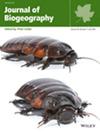Wind Direction and Strength Determine the Genetic Structure of an Insect-Pollinated Plant Across Heterogeneous Landscape
Abstract
Aim
Dispersal of plant propagules and their genes is crucial for plant responses to landscape heterogeneities, yet the mechanisms behind this dispersal remain unclear. Ficus species depend on wind-borne fig wasps for pollination, but research on airflow effects on Ficus genetic structure has produced conflicting results. Our study aims to clarify the role of wind in shaping the genetic structure of such plants with wind-borne insect pollinators by examining how geomorphological complexity interacts with air movements to influence genetic structures.
Location
Southwest China: Sichuan, Yunnan, Guangxi and Guizhou provinces.
Taxon
Ficus tikoua Bur., Ficus, Moraceae.
Methods
We sampled 56 F. tikoua sites across southwest China, characterised by high geomorphologic complexity. River basins and predominant winds were visualised across the sampled regions. Wind connectivity between sampled sites during the main pollination season was modelled based on hourly daily wind data. The maternal and biparental genetic structure of sites were reconstructed using chloroplast DNA (cpDNA) and nuclear SSR (nuSSR) markers. Links between genetic structure, location, and wind parameters were estimated by Mantel or partial Mantel tests.
Results
The plant's maternal genetic structure was defined by river systems, with two distinct cpDNA groups located in the Yangtze and Pearl River basins, respectively. The boundaries for nuclear variation were less clearly delimited geographically. Sites with mixtures of nuSSR groups were concentrated where prevailing winds arrived from several directions. Stronger between-site air flows increased nuSSR geneflow and genetic similarities, while populations receiving more wind flow were also more genetically variable.
Main Conclusions
Our study reveals how plant gene dispersal reflects air and water movements that in turn respond to geomorphologic complexity, thereby directly demonstrating the effects of wind on gene flow of plants with wind-borne insect pollinators. Wind data matching pollinator flight times and large sample sizes are crucial for testing wind effects.

 求助内容:
求助内容: 应助结果提醒方式:
应助结果提醒方式:


